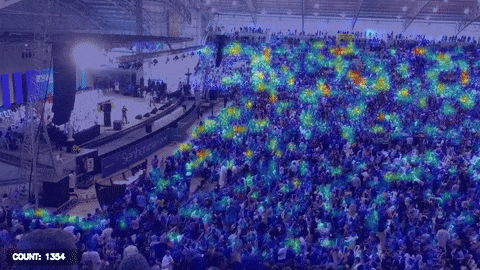Crowd Counting
Overview
In Computer Vision (CV), crowd counting refers to the technique of counting or estimating the number of people in a crowd. This can be used to estimate the number of people attending an event, monitor crowd levels and prevent human stampedes.

Our solution utilizes CSRNet to estimate the size of a crowd. In addition, it generates a heat map that can be used to pinpoint possible bottlenecks at a venue. This is explained in the How It Works section.
Demo
To try our solution on your own computer, install and run PeekingDuck with the configuration file crowd_counting.yml as shown:
Terminal Session
You may like to try it on this sample video.
How It Works
There are two main components to our solution:
Crowd counting, and
Heat map generation.
1. Crowd Counting
We use an open source crowd counting model known as CSRNet to predict the number of people in a sparse or dense crowd. The solution uses the sparse crowd model by default and can be configured to use the dense crowd model if required. The dense and sparse crowd models were trained using data from ShanghaiTech Part A and Part B respectively.
As a rule of thumb, you might want to use the dense crowd model if the people in a given image or video frame are packed shoulder to shoulder, e.g., stadiums. For more information on how to adjust the CSRNet node, check out its configurable parameters.
2. Heat Map Generation (Optional)
We generate a heat map using the density map estimated by the model. Areas that are more crowded are highlighted in red while areas that are less crowded are highlighted in blue.
Nodes Used
These are the nodes used in the earlier demo (also in crowd_counting.yml):
nodes:
- input.visual:
source: <path/to/video with crowd>
- model.csrnet:
model_type: dense
- draw.heat_map
- draw.legend:
show: ["count"]
- output.screen
1. Crowd Counting Node
As mentioned, we use CSRNet to estimate the size of a crowd. As the models were trained to recognize congested scenes, the estimates are less accurate if the number of people is low, i.e., below ten. In such scenarios, you should consider using the object detection models included in our repo.
2. Heat Map Generation Node (Optional)
The heat map generation node superimposes a heat map over a given image or video frame.
3. Adjusting Nodes
Some common node behaviors that you might want to adjust are:
model_type: This specifies the model to be used, i.e.,sparseordense. By default, our solution uses the sparse crowd model. As a rule of thumb, you might want to use the dense crowd model if the people in a given image or video frame are packed shoulder to shoulder, e.g., stadiums.width: This specifies the input width. By default, the width of an image will be resized to 640 for inference. The height of the image will be resized proportionally to preserve its aspect ratio. In general, decreasing the width of an image will improve inference speed. However, this might impact the accuracy of the model.